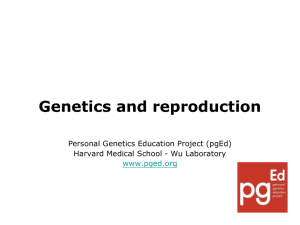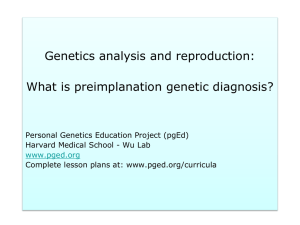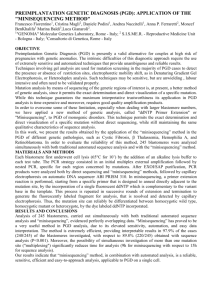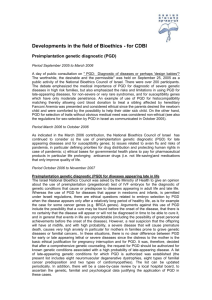care program for prospective parents with a - UZ Brussel-VUB
advertisement
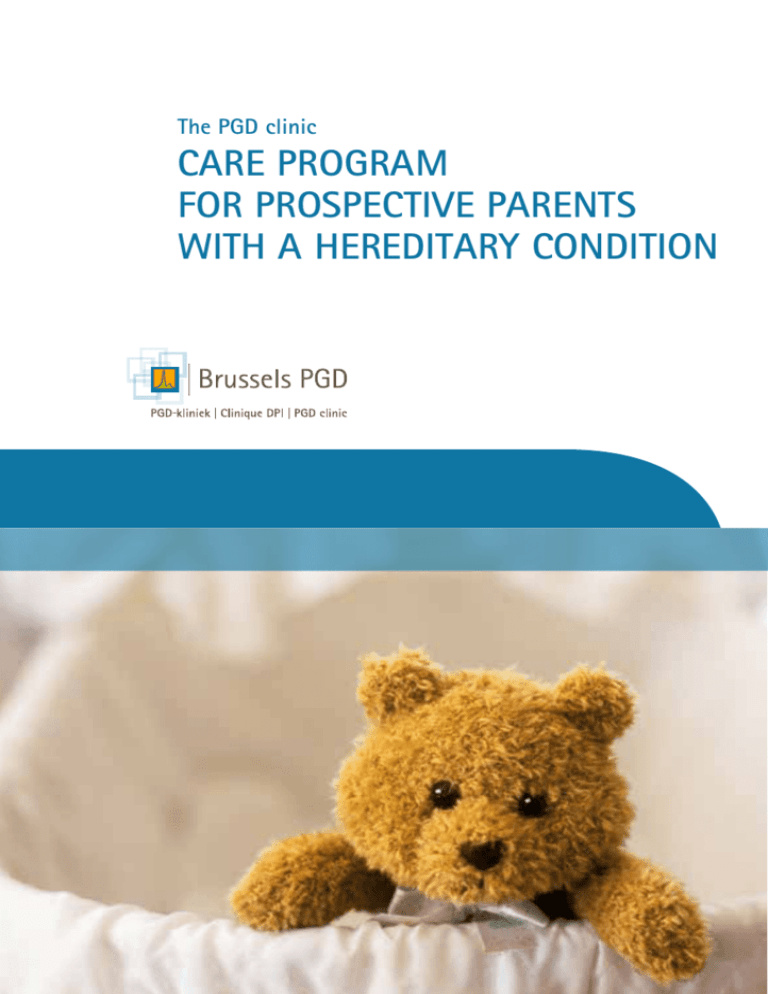
The PGD clinic CARE PROGRAM FOR PROSPECTIVE PARENTS WITH A HEREDITARY CONDITION CONTACT DETAILS PGD-kliniek Universitair Ziekenhuis Brussel Laarbeeklaan 101, B-1090 Brussel (Jette) www.brusselspgd.be Centrum voor Medische Genetica (CMG) PGD Treatment Coordination +32 2 477 60 71 pgd@uzbrussel.be Centrum voor Reproductieve Geneeskunde (CRG) Contact Centre +32 2 477 66 99 > or general information and appointments crg@uzbrussel.be (!) (!) Please note! No electronic communication about your treatment is possible. Treatment planning +32 2 477 66 19 Daily Patient Monitoring (DM) For external investigations, please send the results of blood tests and ultra sound scans before 2:00 pm by fax or e-mail +32 2 477 88 88 Andrology laboratory > appointments for semen analysis CRG Ward Operating Theatre +32 2 477 66 52 COLLABORATING DEPARTMENTS Medical Genetics Department > for information about PGD Radiology Department Prenatal medicine Children’s hospital admissions department Billing fax +32 2 477 88 89 crgdm@uzbrussel.be +32 2 477 66 44 +32 2 477 66 20 +32 2 477 68 71 pgd@uzbrussel.be +32 2 477 60 50 +32 2 477 60 20 +32 2 477 87 78 +32 2 477 55 42 FOR PAYMENTS BY DIRECT BANK TRANSFER (CMG) FOR PAYMENTS BY DIRECT BANK TRANSFER (CRG) IBAN: BE86 4324 0168 7150 BIC: KREDBEBB REF.: CRG / PATIENT NAME / DATE OF BIRTH IBAN: BE86 4324 0168 7150 BIC: KREDBEBB REF.: CRG / PATIENT NAME / DATE OF BIRTH The PGD clinic CARE PROGRAM FOR PROSPECTIVE PARENTS WITH A HEREDITARY CONDITION CONTENT The UZ Brussel PGD clinic p. 6 Genetics and Reproductive Medicine working together for you A hereditary risk but would like to have a child? p. 8 PGD as a possible outcome The treatment step by step Phase 1 – The preliminary process p. 11 Contact the PGD coordinator p. 12 Consultations – good preparation is half the battle p. 13 • consultation with the genetics doctor p. 14 • consultation with the fertility gynaecologist p. 14 • informative discussion with the counsellor p. 14 • travel for consultations and during treatment PREIMPLANTATION GENETIC DIAGNOSIS 4 Phase 2 – The development of the PGD test p. 15 What types of PGD tests are there? p. 16 How long does it take to develop the test? Phase 3 – Medically assisted procreation in PGD: ICSI p. 17 The discussion with the counsellor p. 18 Planning and start of treatment p. 18 IVF/ICSI in a nutshell p. 19 • the course of hormonal stimulation p. 20 • egg retrieval p. 20 • in the laboratory • fertilisation of the egg via ICSI • the embryo biopsy • post-retrieval analysis: possible status of each embryo p. 21 • the embryo transfer p. 23 • freezing the embryos p. 23 • monitoring the result p. 23 • follow-up study of your pregnancy p. 24 Phase 4 – Postnatal follow-up There is also PGS p. 25 How and why we count chromosomes p. 25 The difference between PGD and PGS p. 26 Which chromosomes can we test today? p. 26 Analysis of the embryos and embryo transfer p. 27 The value of PGS Practical details of the PGD treatment p. 28 Coordination & appointments p. 29 The financial aspect p. 29 Consent contracts p. 30 • what about supernumerary embryos? Frequently asked questions about PGD p. 31 How reliable is PGD? p. 32 How safe is PGD? p. 32 How great is the chance of success of PGD treatment? p. 33 How can you improve your chance of success yourself? p. 34 Want to know more? • and meet the PGD team (photo) 5 UZ BRUSSEL PGD CLINIC PREIMPLANTATION GENETIC DIAGNOSIS GENETICS AND REPRODUCTIVE MEDICINE WORKING TOGETHER FOR YOU 6 IVF stands for in vitro fertilisation, literally: fertilisation in glass i.e. in a Petri dish in the laboratory. ICSI is the abbreviation for intracytoplasmic sperm injection, that is the injection of one sperm cell into each egg. If you want children and also have a genetic disorder, you can approach UZ Brussel for special treatment: PGD or preimplantation genetic diagnosis. PGD means that embryos obtained via in vitro fertilisation (IVF) are diagnosed genetically first and only then returned to the uterus. That means that you must undergo treatment known as IVF/ICSI. This involves developing the embryos in the laboratory, enabling us to genetically diagnose them before we introduce them into the uterus. In other words PGD treatment requires close collaboration between the Centrum voor Medische Genetica (Centre for Medical Genetics, CMG) and the Centrum voor Reproductieve Geneeskunde (Centre for Reproductive Medicine, CRG) of UZ Brussel. Together they form the PGD clinic. 700 600 500 PGS PGD CYTO PGD DNA 400 300 200 100 19 93 19 94 19 95 19 96 19 97 19 98 19 99 20 00 20 01 20 02 20 03 20 04 20 05 20 06 20 07 20 08 20 09 20 10 20 11 20 12 20 13 0 Twenty years’ expertise in PGD The very first PGD was performed in 1990 in Great Britain. Since then PGD has been used in specialised centres around the world. Since 1993 it has also been performed at UZ Brussel. In the meantime our PGD clinic has expanded to become one of the leading centres in Europe. Regarding scientific research into children born of PGD treatment, UZ Brussel is also at the absolute top: as one of the few centres in the world we have consistently monitored all babies that we have helped set foot in the world via this treatment. For the PGD clinic this postnatal follow-up is an indissoluble part of the treatment. This graph depicts the number of PGD cycles we have performed in the previous twenty years in UZ Brussel, together with the type of genetic analysis of the embryo. Centrum voor Medische Genetica This brochure draws together all the information that you need if you want to undergo PGD treatment. For the most recent information update, please consult our websites: www.brusselspgd.be, www.brusselsgenetics.be and www.brusselsivf.be. 7 A HEREDITARY RISK BUT WOULD LIKE TO HAVE A CHILD? PREIMPLANTATION GENETIC DIAGNOSIS PGD MAY BE THE SOLUTION 8 As mentioned before the UZ Brussel PGD clinic offers treatment for people who would like a baby but who are at increased genetic risk. Preimplantation genetic diagnosis is a procedure that enables us to detect a hereditary disorder in embryos that are obtained via IVF even before they are returned to the uterus. In PGD we very carefully remove in the laboratory one, sometimes two or more cells from an eight-cell or many-cell embryo. The genetic analysis of that cell or those cells is called the PGD test. The purpose is to find out which embryos exhibit the genetic defect and which ones do not. Only unaffected embryos may be implanted in the uterus. Why PGD? PGD can be regarded as a very early prenatal diagnosis. If you run the risk of passing on a hereditary disorder to your child(ren), you can find out by an invasive prenatal test (chorionic villus sampling, amniocentesis, umbilical cord blood sampling) whether the foetus has inherited the disorder. These tests are invasive meaning they take material (tissue or fluid) from the fetus, uterus or placenta. In PGD that diagnosis is not obtained during the pregnancy, but with the embryos grown in vitro, before one (or more) of them are implanted in the uterus. In other words you get the chance of becoming pregnant without the future baby inheriting the genetic abnormality. By doing it this way you can avoid the difficult decision of whether to terminate the pregnancy. Are you eligible? PGD treatment is specifically intended for prospective parents with an increased risk of a child with a genetic abnormality or for prospective parents with reduced fertility as the result of a genetic problem. It is important that we have sufficient information about the disorder, so that we know which genetic defect we are looking for. It might be a defect in the chromosomes or in one particular gene. An outline of the treatment process If you are eligible for PGD treatment and decide to have it, your treatment will proceed as follows. • The preliminary process • consultation with the genetics doctor • consultation with the fertility gynaecologist • preliminary examinations and tests in connection with your PGD treatment • Development of the PGD test the time needed to develop the test may vary from a few weeks to several months Preliminary examinations PGD test weeks months 1 9 PGD test weeks months 1 2 A E F B D C Follow-up to step OR step 1 2 E • Assisted Reproductive Treatment (ART) • analysis of the results with the fertility gynaecologist and the genetics doctor (1) - counselling by the fertility counsellor - planning and start of the treatment • ovarian stimulation (2A) • egg retrieval (2B) • in the lab (2C and 2D): - ICSI fertilisation of the egg and embryo culture - embryo biopsy and genetic diagnosis of the embryos • embryo transfer (2E): implantation of one (or several) un­ affected embryo(s) either in the current cycle, or a following cycle after freezing and storage of the embryos • in the lab (2F): freezing (all or surplus) embryos • if successful – monitoring of early pregnancy • if not pregnant: transfer of thawed embryos (frozen (thawed) embryo transfer, FRET) or a new IVF/ICSI cycle PREIMPLANTATION GENETIC DIAGNOSIS • Any baby or babies that were born as the result of PGD treatment will be invited for pediatric follow-up 10 It may well be possible that in the course of the treatment program you decide not to start the PGD treatment or not to proceed with it. In that case the entire procedure will be put on hold. The same applies if the preliminary tests were to indicate that you are not eligible for PGD. The PGD clinic can if desired provide (psychological) support and an alternative way of fulfilling your desire for children. THE TREATMENT STEP BY STEP PHASE 1 – THE PRELIMINARY PROCESS PGD is specifically intended for people who are planning a family. They are prospective parents – with or without a fertility problem – who are at increased risk of passing on a hereditary disorder to their children. Prospective parents who have reduced fertility or are infertile as the result of a genetic problem are obviously eligible for PGD as well. Contact the PGD coordinator If you want to book a clinic appointment because you are consider­ ing PGD treatment, please send an email to pgd@uzbrussel.be. This will be dealt with by the PGD coordinator. • In the email please state the full name, date and place of birth and address(es) of both of you and give a short description of the disorder and your history. 11 • If you can provide any medical or genetic reports, please enclose copies via email or fax. • Foreign couples are requested to send a copy of both passports. Once we have sufficient information, we will invite you to the PGD clinic. Outpatient clinic appointments good preparation is half the battle However, and even if you have given your consent, you can decide to stop the PGD procedure at any time. Elke PGD-behandeling begint met twee consultaties (soms drie). • Each PGD treatment begins with two outpatient appointments (sometimes three). • a consultation with a geneticist, who checks that the conditions are eligible for developing a PGD test. If this is the case you will meet the PGD coordinator and/ or a social care nurse at the same time. They will discuss the practical course of events with you and go through the PGD consent form with you. Signing this consent is required to allow start of the treatment • a consultation with a fertility gynaecologist, who assesses whether you are eligible to undergo IVF treatment. • In specific cases a psychological consultation is organised. We do this for all enquiries involving HLA typing, for patients who are single and for some of the ‘late onset’ hereditary disorders. PREIMPLANTATION GENETIC DIAGNOSIS If all assessments are positive the necessary blood samples are collected in order to develop a PGD test (for the genetic analysis of the embryos). 12 Consultation with the geneticist During this consultation the doctor – a clinical geneticist (a medical expert in hereditary conditions) – will go through the available data regarding yourself, your partner and family members. What can you do to help this consultation run efficiently? • Bring as much information as possible regarding your genetic disorder, such as the results of genetic tests and letters from doctors. • Other information that you can provide us with or that we can assemble together: • the medical family tree of at least two generations, but preferably four: your own generation (including any brothers and sisters), that of your parents, that of any children already born to you, and possibly that of your grandparents; man woman • the name and date of birth of family members foetus with the genetic disorder; • any clinical and/or genetic reports of the family members who have the disorder. normal carrier affected deceased After the consultation we give you requests for blood tests, for yourself and possibly for family members. Your blood samples are taken at UZ Brussel, as the analysis is usually also performed in-house. Family members from whom we need a blood sample can visit their general practitioner or an external lab to get the sample taken The samples or results will then be forwarded to us. 13 Consultation with the fertility gynaecologist In preparation for this consultation you can fill out an extensive questionnaire, which you can download – one for the woman, one for the man – from the CRG website www.brusselsivf.be. If at all possible, we would like to receive the completed questionnaires in advance. The fertility gynaecologist investigates the state of your fertility (both of you) and as such requests a number of (blood and other) tests. Counselling Once the PGD test has been developed, we will invite you for another appointment. You will see the geneticist and fertility gynaecologist again, however this time there is also an important and lengthy conversation with the PGD counsellor scheduled. This counsellor will go through the prescribed treatment schedule with you. The legal and practical aspects of the PGD treatment are discussed so that you are sufficiently informed to be able to sign the necessary contracts. Because of the practical nature of this counselling session, it is best held as near as possible to the treatment itself. PREIMPLANTATION GENETIC DIAGNOSIS Travelling for the consultations and during treatment 14 For Belgian patients at least two hospital visits are scheduled before the treatment can start. For foreign patients or those living at a long distance we try to keep the travelling to a minimum and schedule a one-stop combined program of consultations. The counselling therefore takes place at the first visit to our clinic. Further appointments are made by telephone or email. During the first phase of the treatment i.e. the ovarian stimulation you are not required to be in Brussels; monitoring of this part of the treatment can be done while you are at home. For the egg retrieval and the transfer of the embryo (or embryos) you do have to come into hospital, for a couple of hours each time. PHASE 2 DEVELOPMENT OF THE PGD TEST As soon as the CMG has all the necessary reports and samples and has identified the genetic abnormality, the development of the PGD test begins. The aim of this is to obtain a reliable genetic diagnosis on one or more cells from an embryo. The time taken to develop the PGD test varies at present from a few weeks – for common indications – to eight months or longer – in rare or new indications. It is important to know that the development and completion of a PGD test can take a few weeks to several months. Please do not become pregnant spontaneously Once we start developing the PGD test, we ask you to have only protected intercourse and stop any attempt to become pregnant without our assistance. This is because the develop­ment of a test is individual and time-consuming. Furthermore a natural pregnancy does not allow the bene­ fit of an advance genetic diagnosis of the developing baby. However, if you do become pregnant in the test development period, of course you can decide to have a prenatal diagnosis. What types of PGD tests are available? Different types of PGD tests serve different purposes. • In monogenetic disorders the PGD test can detect an abnormality on one gene. • In chromosomal abnormalities the test serves to detect abnormalities on the chromosomes (number, structure). We can: • count (particular) chromosomes, or • look at the structure of the chromosomes. We do this to analyse the normal/balanced segregation pattern in chromosome translocations. • In X-linked disorders, thanks to the PGD test we can determine the gender of the embryos. Then depending on the disorder only female or only male embryos can be considered for return to the uterus. In most X-linked disorders we are however able to perform a mutation-specific analysis and thus return both healthy male and female embryos. 15 Ethical principle Determining the gender of embryos is only legally allowed in Belgium for medical reasons. The personal preferences of people who would like to be parents can never be an indication for a sex selection. • Another type of PGD is HLA typing. This special PGD test examines which embryos have the same tissue type as an existing, seriously ill child of the same parents. Children with a particular (fatal) blood or immune system disorder can sometimes be cured by a blood and marrow stem cell transplant. That is only possible if the transplanted cells are HLA compatible with the cells of the sick child. If they are not compatible, then they are rejected. In other words a baby born from an HLA treatment can be a donor to save a sick brother or sister. Such a baby is also called a ‘saviour baby’ or ‘donor baby’ in the media. How long does it take to develop a test? PREIMPLANTATION GENETIC DIAGNOSIS Thanks to new diagnostic techniques (SNP arrays) we will however be able to shorten the waiting time considerably in the near future. SNP array is a method of detecting single nucleotide polymorphisms (SNPs or point mutations). 16 The development of a PGD test can take a few weeks to a few months, depending on the disorder. Up till now, each disease has required a separate, often individualised test. In order to develop the test, we first need a genetic blood analysis of both prospective parents. With a monogenetic disorder we often also do a blood or DNA test of family members. We then explore how the wrong DNA code was transmitted and where precisely in the embryo’s DNA we have to search for the problem. For some of the conditions we have already developed a PGD test with a number of markers. Therefore we will first examine whether you fit the existing test. If that is the case, we can finish the test in a reasonably short period of time, in two to three months. If this is not the case, then we have to develop a new test which can take some six to eight months. The UZ Brussel PGD clinic can provide genetic analysis of embryos: • for all monogenetic diseases whose genetic defect is known. The complete list – which is continually being updated - can be found on www.brusselsgenetics.be. Below are some examples: • cystic fibrosis • sickle cell anaemia • Steinert’s disease (myotonic dystrophy) • Huntington’s disease • Marfan syndrome • Neurofibromatosis type I and type II and as examples of X-linked conditions: • Duchenne muscular dystrophy • fragile X syndrome • haemophilia A • to detect chromosomal translocations. Two types of displacement of a DNA segment from one chromosome to another (non-homologous) chromosome are recognised: the reciprocal and the Robertsonian translocations (cf. the drawing below); • and for chromosomal screening (PGS, see p. 25 and following pages). PHASE 3 MEDICALLY ASSISTED REPRODUCTION AND PGD: ICSI As soon as the PGD test is ready, you will come again for a consultation with the genetics doctor and the fertility gynaecologist. The latter will prescribe a medically assisted fertilisation treatment (IVF with ICSI, see below). Then follows the interview with the fertility counsellor. The counsellor interview The counsellor (a nurse or midwife) runs over the whole IVF/ICSI treatment with you: • practical: planning, starting date, how and with whom to make appointments, the where and when of interventions, how and with whom to communicate during your treatment, what follow-up is provided if you become pregnant, etc.; 17 • medical: what happens during your treatment, what medication you have to take (and how), your preparation for egg retrieval and embryo transfer (and what follows?), …; • administrative and financial: registration as patient of UZ Brussel, the cost of the treatment, the conditions for reimbursement (for Belgian patients who are eligible for health insurance cover), the contracts that you will have to sign, ... Scheduling and starting treatment • Your PGD treatment can only be included in the clinic’s schedule once the PGD test is ready. • You cannot begin a PGD treatment that has not been planned. In other words a date must be set on which you can start taking medication for ovarian stimulation. • The starting date is usually fixed during the conversation with the counsellor or the fertility gynaecologist. If that did not happen, then you must arrange the starting date in discussion with the CRG scheduling coordinator. You can find the telephone number on the inside cover of this brochure. • You are expected to start on the day arranged, so we can offer you the best treatment. If you miss the start for any reason, the treatment must be postponed and rescheduled. IVF/ICSI in a nutshell PREIMPLANTATION GENETIC DIAGNOSIS With in vitro fertilisation the egg is not fertilised in the fallopian tube by the sperm cell, but outside the woman’s body, in a plate in the laboratory (‘in vitro’ means ‘in glass’). In PGD we always use ICSI as the fertilisation technique, that is to say we inject one sperm cell into each egg. Then the plate goes in an incubator that imitates the conditions of the uterus as closely as possible. 18 For a complete description see www.brusselsivf.be On the following pages, we briefly go through the sequence of steps of IVF/ICSI treatment. IVF/ICSI in a nutshell stimulation 9 days stock of follicles suppression 5 days egg retrieval 12 days pregnancy test or injection/maturation hCG ICSI The course of hormonal stimulation Your natural menstrual cycle is temporarily replaced by a medically -controlled cycle. At the same time you are given hormones to stimulate the ovaries. The intention is to get as many eggs to develop as possible. Important During the IVF treatment there is a small risk of ovarian hyperstimulation, in which fluid accumulates in the abdominal cavity. Sometimes hospitalisation is necessary to treat this problem. We therefore strongly advise you to follow the instructions of the fertility doctor and the DM [daily patient monitoring] exactly. After all, this team is striving for a maximum number of good-quality eggs with a minimal risk of ovarian hyperstimulation. Important As a PGD patient you were asked at the start of the test development to stop having unprotected sexual relations. This is to prevent you getting pregnant naturally, without the chance of carrying out a genetic test on the embryo. That request is even more important in this ‘stimulated’ period: from the week before up to one week after the egg retrieval we ask you not to have unprotected sex under any circumstances. 19 The egg retrieval Using blood tests we monitor when we can expect the ovulation. Immediately before this we insert a fine, hollow needle into the ovaries and collect the mature eggs. We call this egg retrieval, a procedure that requires a stay in hospital during half a day. Mandatory screening for hepatitis B and C, HIV and syphilis With each new IVF/ICSI attempt we screen for hepatitis B and C, HIV and syphilis. In doing this we are obeying an EU directive: we are required to know the result of the infection test for every patient who donates tissue - eggs, sperm cells, embryos - before the start of each treatment cycle. This means that the presence of the man on the day of the retrieval is almost always required. Only if you have provided your sperm sample beforehand and had it frozen or if your treatment involves donor sperm, your presence is not necessary. In the laboratory Fertilisation of the eggs via ICSI For the fertilisation we use ICSI: the injection of one sperm cell into each egg. This is because this fertilisation technique provides the most embryos and avoids problems in the execution of the genetic test on the embryonic cells: of all eggs collected and fertilised ninety percent develop into an embryo. The embryo biopsy 1 1| ICSI: injection of one sperm cell into each egg A biopsy consists of the removal of small amounts of material from the embryos that have developed in vitro. This provides us with two options: Option 1 On day three after fertilisation we remove one (or two) cell(s) for genetic analysis. While the diagnosis is being made on the removed cell(s) the development of the embryos from which the biopsy was taken continues in the incubator, until day five. 2 2| DThe embryo biopsy on day 3 20 Option 2 The introduction of new techniques has recently made it possible to perform the genetic diagnosis only on day five after fertilisation. With this method we remove a small piece of trophectoderm from the developing embryos, which gives us more cells hence more DNA material. Because it takes more than twelve hours for us to analyse that material (and it is better not to return embryos later than day 5 or 6), we freeze the biopsied embryos. Post-retrieval analysis: possible status of each embryo • ‘healthy’ for the genetic defect tested for and of good morphological quality; • ‘healthy’ for the genetic defect tested for and of poor morphological quality; • embryo displays the tested defect and is morphologically of good or poor quality; • In the case of HLA typing: HLA-compatible embryos versus ‘healthy’ but not HLA-compatible; • no diagnosis reached. 3 3 | The trophectoderm biopsy on day 5. The trophectoderm is the layer around the fetal cells. It is made up of the cells that will later form the placenta. The risk of the embryo transfer having to be cancelled after the genetic analysis is on average twenty percent. Embryo transfer Embryos that are genetically healthy and of good morphological quality are eligible for return to the uterus. This procedure is called embryo transfer and is best done in a short hospital admission. Option 1 & 2– after biopsy on day 3 We know the result of the genetic analysis at day five of embryo development. Either one or two selected embryo(s) are returned to the uterus in the current cycle and the supernumerary embryos are frozen. Or all embryos are frozen for transfer in a later, non-stimulated cycle. Option 2– after biopsy on day 5 All embryos are frozen for transfer in a later, non-stimulated cycle. Which embryos • Only embryos that have been found to be normal after the genetic analysis are returned to the uterus. • Embryos that have been found to be abnormal or about which the genetic analysis did not give sufficient information, are not considered for transfer. In the exceptional case that we 21 do transfer such an embryo, you will sign a separate consent form for that purpose. How many embryos? We put one or two – or sometimes three – unaffected embryos back in the uterus. That number is regulated by the legal guidelines on IVF. Determining factors are your age (the woman) and how many treatment cycles you have had in total. But the quality and the genetic status of the embryos will naturally also play a role, as well as the number of available embryos. PGD procedure with biopsy on day 3 10 eggs after egg retrieval day 0 7 to 8 fertilised eggs day 1 5 or 6 embryos for biopsy day 3 Diagnosis after biopsy on 1 cell day 4 Transfer of 1 or 2 embryos day 5 no diagnosis not affected affected not affected, poor quality ? discussion Pregnant/Not pregnant 20-30% Transfer and/or freeze No transfer PGD procedure with biopsy on day 5 10 eggs after egg retrieval day 0 PREIMPLANTATION GENETIC DIAGNOSIS 8 fertilised eggs day 1 22 4 of 5 embryos for biopsy day 5 Freezing all embryos Diagnosis after biopsy after day 5 Transfer in a later, non-stimulated cycle no diagnosis not affected ? discussion Transfer affected not affected, poor quality Freezing embryos We have already seen that it is possible to freeze all the resulting embryos for return to the uterus in a later cycle. But even if we return one (or two) embryos in the current cycle, we can freeze supernumerary embryos of good quality. If you do not become pregnant at the first attempt or later you want another child, then we can use these preserved embryos in a following cycle. You decide what should be done with any supernumerary embryos (to freeze or not to freeze). You will establish that in a contract before the start of your treatment. (See also ‘Practical details’, p. 30). Monitoring the result Approximately twelve days after the retrieval we perform a pregnancy test on a blood sample. You can also get your general practitioner to take the blood sample and get it analysed by a laboratory of his or her choice. Of course you must let us know the result. In other words, in approximately two weeks you will know whether a returned embryo has implanted in the uterus and whether you are pregnant. If you are not pregnant, you will get a follow-up appointment with your fertility gynaecologist for an analysis of your treatment and to discuss further possible investigations and treatment. If you are pregnant, then we will schedule another ultrasound check, six to seven weeks after the embryo transfer. You can also get this check done elsewhere, but again we ask that you pass on the results to us. After this we schedule a further consultation in the PGD clinic to discuss your pregnancy. At that stage we will ascertain whether you want a prenatal diagnosis (chorionic villus sampling or amniocentesis) as a check-up. Follow-up study of your pregnancy In addition to the echographic check in the seventh week we arrange a follow-up study of your entire pregnancy. For this we give you a questionnaire on two occasions, one at the end of the first trimester and one shortly after giving birth. 23 The follow-up of pregnancies that have resulted from ART [assisted reproductive technology] treatment in UZ Brussel is in line with our ambition as scientists to collect as much data as possible about the possible consequences of our treatments. PHASE 4 – POSTNATAL FOLLOW-UP PREIMPLANTATION GENETIC DIAGNOSIS Since 1984 – directly after the fertility clinic started at UZ Brussel – the Centrum voor Medische Genetica has conducted follow-up studies of children who were born from ART treatment at the Centrum voor Reproductieve Geneeskunde. Today we possess data from more than 15,000 children, which is 95 to 98 percent of all ‘UZ Brussel babies’. This makes our hospital the absolute world leader in this field. The follow-up of PGD children consists today of two consultations with a paediatrician: the first when your baby is two months old, the second around the second birthday. For you as a PGD patient the postnatal monitoring of your baby and toddler actually forms the closure of your treatment. So we strongly urge our PGD patients to collaborate with this scientific research. You do not necessarily have to come to Brussels; the postnatal tests and the consultations can also be done by your own paediatrician. We do however ask you to send us the results. Meanwhile you do not have to worry about your privacy: we process all data in complete anonymity. 24 AND THEN THERE IS PGS HOW AND WHY WE COUNT CHROMOSOMES In PGS or preimplantation genetic screening we count the number of all chromosome pairs in one or several cells of the embryo. Embryos with an abnormal number of chromosomes are termed aneuploid, hence this technique is also called ‘screening for aneuploidy’. Aneuploid embryos are not returned to the uterus because they are not viable or can give rise to the birth of a child with problems. Difference between PGD and PGS In PGD we are looking for one particular hereditary gene defect: in the lab we already know what defect on what chromosome or gene we are looking for. In PGS by contrast we are not evaluating one particular gene or chromosome, rather we count the chromosomes in the cells that we have obtained from the embryo. 25 Thanks to PGS we can make a selection in the lab of fertilised embryos, not only based on their morphology (the structure and the number of cells), but also on their chromosomal contents. Which chromosomes can we test today? A standard technique – fluorescence in situ hybridisation or FISH – works with coloured DNA markers and enables the analysis of chromosomes 13, 16, 18, 21, 22, X and Y. These chromosomes often lie at the root of miscarriages or are involved in a number of severe abnormalities such as trisomy 21 (Down’s syndrome). A more recent technique uses microarrays and enables us to count all the chromosomes. At this point in time we nearly always use this technique for PGS. What’s a DNA microarray? A DNA microarray (also commonly known as DNA chip or biochip) is a collection of microscopic DNA spots attached to a solid surface(in glass orplastic). The technique allows us to analyse the amount of DNA present in an embryo bioptand to deduce whether the sample contains a normal count of chromosomes. PREIMPLANTATION GENETIC DIAGNOSIS Analysis of the embryos and embryo transfer 26 In PGS we prefer to perform the genetic analysis on day five after fertilisation, because then we can examine several cells and thus more DNA. It is also possible that we perform a biopsy at day 3, with the same microarrays, and that we freeze the embryos at day 5 of development. In short, in all cases the transfer back of the embryos with normal chromosomes is scheduled for a later, non-stimulated cycle – and after the genetics doctor has discussed the result of the screening with you. Nevertheless, if only a limited number of embryos are available at day three of development, it may be possible – after discussing it with your doctor – not to perform genetic screening and simply return the available embryos to the uterus. The value of PGS Today there is much discussion about the value of PGS. A number of studies have demonstrated that it does not increase the chance of pregnancy. In a number of cases PGS can however help us to understand IVF failure better. The new techniques of genetic screening using microarrays are nevertheless promising. They are more accurate and enable all chromosomes to be analysed. Whatever the verdict, further studies are necessary to confirm the added value of aneuploidy screening in the context of IVF treatment. If your doctor prescribes PGS because it may be useful to you, the PGD clinic will try to genetically screen as many embryos as possible. Depending on the number, the quality and the genetic condition of your embryos it is however always a possibility that no embryos can be transferred. PGS can also be performed on eggs, but then of course the analysis only supplies information about the egg and not about the sperm cell. Therefore we only do this sort of screening in connection with a study, all the more so because screening is very labour intensive. 27 PRACTICAL DETAILS OF THE PGD TREATMENT COORDINATION & APPOINTMENTS During the first phase of PGD treatment all appointments are arranged via the PGD coordinator, by telephone or email. During the IVF/ICSI cycle appointments are made via the CRG services: the contact centre, the scheduling coordinator and Daily Patient Monitoring (DM). All contact details can be found on the cover of this brochure. PREIMPLANTATION GENETIC DIAGNOSIS Cancellation of an appointment 28 If you cannot come to an appointment for a consultation or an examination, please let the PGD coordinator know at least a few days in advance, briefly giving the reason. During your IVF/ICSI treatment your medical appointments are usually made via the DM. Cancellations can also be dealt with via that service. If you do not turn up without warning or repeatedly for appointments or examinations, UZ Brussel may charge you for this. Registration in the hospital Each time you come to UZ Brussel for a consultation or examination, please register first. If you are coming to a consultation as a couple, you must both check in. THE FINANCIAL ASPECT For information about the cost of PGD treatment please contact the PGD coordinator. There is also a document containing financial information, which is regularly updated. You can request it from the PGD coordinator, the CRG contact centre or the fertility counsellor. For Belgian patients who are eligible for health insurance support, the form goes into more detail about the criteria for reimbursement of the treatment. However, health insurance entitlement does not always mean that you are eligible for reimbursement. Finally, in UZ Brussel every consultation, examination or procedure must be paid for with a credit card or via bank transfer (after receipt of an invoice). Cash and cheques are not accepted. In PGD treatment the cost of developing the test must be paid for in full before development work starts. CONSENT CONTRACTS At the start of PGD treatment we ask you to take a number of decisions and to give your consent in writing. This is done via a number of contracts: • the consent for PGD; • the consent for medically assisted procreation; • the decision on what will be done with supernumerary embryos; • the consent for scientific research that uses human gametes and embryos; • in certain cases: the consent for the use of donor sperm; • … The fertility counsellor will go through all the forms with you during the preparatory interview. By signing the contracts you (both) declare that you have been extensively informed before the start of the treatment about all medical aspects of the treatment and that that information was sufficient for you to make a well-informed decision. 29 PREIMPLANTATION GENETIC DIAGNOSIS You can later review all decisions that you take, but that must always be done in writing. If you signed the original consent form as a couple, then you must both also sign the amended decision. 30 What happens to supernumerary embryos? In PGD treatment the decision about what to do with supernumerary embryos becomes more complex than with the usual IVF/ICSI treatment. Supernumerary embryos are embryos that you cannot or not immediately return to the uterus, either because more have developed than you need, or because they are genetically defective. • For the healthy embryos you must decide if you will have them frozen for use in a possible new attempt, donate them for scientific research or have them destroyed. Surrendering for donation to other prospective parents is not an option following PGD. • Diseased embryos, embryos for which no diagnosis could be made and embryos of poor morphological quality can be donated for scientific research or destroyed. • In the case of PGD with HLA typing you must decide in a separate contract what is to be done with embryos that are ‘healthy’ but not HLA compatible. FREQUENTLY ASKED QUESTIONS ABOUT PGD HOW RELIABLE IS PGD? PGD is a very reliable diagnostic technique, with a minimal risk of a false diagnosis. You can get a control diagnosis performed via a prenatal test (chorionic villus sampling or amniocentesis) during your pregnancy. At that point we can determine with even more certainty whether the foetus has the disorder we are testing for or not. At that time we can also look for other possible problems, such as Down’s syndrome. Unfortunately an invasive prenatal examination also entails a small risk (a half to one percent) of a miscarriage. In addition the UZ Brussel medical genetics service offers in many, but not in all cases, the possibility of having a control diagnosis performed after the birth of your baby. 31 HOW SAFE IS PGD? In PGD we very carefully remove one or sometimes two or even several cells from an eight- or multi-cell embryo. As a rule the embryo remains unharmed and continues to develop normally after the procedure. As of 2013 between 20,000 and 30,000 children worldwide have been born following IVF/ICSI combined with PGD. From the postnatal monitoring of the first 1,000 babies – who were born in UZ Brussel following PGD treatment – it appears that at birth the great majority are healthy. As a rule they are at least as healthy as babies born after the ‘usual’ IVF, with or without ICSI. In the CRG we have seen three hundred of these babies at the age of two. In comparison with the same number of ICSI babies and babies born following natural conception they are equally healthy and display comparable development. Data from the PGD consortium and ESHRE confirm that the health of newly born PGD children is comparable to that of ICSI and IVF children. So performing an embryo biopsy does not seem to constitute an increased risk of miscarriage. Further follow-up studies remain necessary however, certainly in the long term. Hence all couples who become pregnant through PGD treatment are asked to take part with their baby(ies) in the CMG follow-up program (see also p. 24). PREIMPLANTATION GENETIC DIAGNOSIS WHAT IS THE CHANCE OF SUCCESS FOR A PGD TREATMENT? 32 In ICSI each egg in the plate is injected with one sperm cell. With this technique we know that approximately ninety percent of the collected eggs are fertilised and develop into an embryo. However, some of the embryos do not survive the removal of one or two cells. And naturally there are some embryos that carry the genetic disorder and so are not eligible for return to the uterus. Also some of the embryos are not successfully diagnosed and some of them are not morphologically good enough to put back. Finally, a replaced embryo does not always implant in the uterus: every returned embryo does not therefore result in a pregnancy. All in all the chance that you will have a baby following PGD treatment amounts on average to twenty to thirty percent. It is however difficult to make a generally applicable statement, since the chance of success differs greatly from one individual to another. It is influenced among other things by your age (that of the woman), the number of eggs obtained and the quality of the embryo(s) transferred. The nature of the genetic abnormality also plays a role. Your individual chance of success is therefore discussed during the consultation with the geneticist and fertility gynaecologist. HOW CAN YOU INCREASE YOUR CHANCE OF SUCCESS? There are a great many things that you – and here we are speaking mainly about the woman – can do to improve the chance of a successful treatment. • Like all women who are considering becoming pregnant or who are taking the first steps in fertility treatment, it is best to start taking folic acid tablets. This food supplement greatly reduces the risk of spina bifida or hare lip/cleft palate in the baby. • Do you smoke? Then it is highly recommended that you stop this habit before you start the treatment – and that you keep this up in pregnancy. • Are you overweight? If you try to lose the surplus kilos beforehand, you increase the chance of success of your treatment. • As soon as you decide to become pregnant, it is best to abstain totally from alcohol. By doing this you are protecting the fledgling embryo and the baby against a possible risk of FAS, foetal alcohol syndrome. • Would you like any more tips? Read the CRG brochure “What can you do yourself? Health advice for people who would like to have a child”. 33 Want to know more? At www.brusselspgd.be you can find the answers to even more Frequently Asked Questions • Why do you need samples from our family members? • What is meant by an ‘available test’? • Why can you not say in advance how long the test development will last? • Why do you need samples? Surely we have all the medical reports about our genetic disorder? It also provides more information about the development of the PGD tests and the work of the CMG laboratories (www.brusselsgenetics.be). PREIMPLANTATION GENETIC DIAGNOSIS The PGD team, from left to right: Prof. dr. Maryse Bonduelle, prof. dr. em. Inge Liebaers, dr. sc. Alexander Gheldof, prof. dr. Willem Verpoest, dr. sc. Pieter Verdyck, ir. dr. sc. Martine De Rycke, prof. dr. Julie Nekkebroeck, PGD coordinator dr. sc. Pascale De Becker, prof. dr. Herman Tournaye, m. sc. Veerle Berckmoes. 34 Also a member of the team, but not in this picture, dr. Ellen Denayer (see photo p. 12). COLOPHON DISCLAIMER This brochure contains crucial information for those who are facing difficulties in conceiving, as well as advice to improve your and your baby’s health. This information is not intended to ignore the medical advice given to you by your treating physician. Specific queries regarding your health status should be addressed to your treating physician, more particularly when symptoms arise that need a specific diagnosis or medical treatment. © Centrum Reproductieve Geneeskunde. This material is protected by copyright. No part of this guide may be reproduced without prior permission in writing from the responsible publisher. Inappropriate or unlawful use is an infringement of the copyright and is a criminal offence. TEXT EDITING - LAYOUT - ILLUSTRATIONS & GRAPHICS - PRODUCTION Magelaan cvba Gent – België PHOTOGRAPHY UZ Brussel Centrum voor Reproductieve Geneeskunde, UZ Brussel Centrum voor Medische Genetica, Bart Moens (photo p. 34) Shutterstock RESPONSIBLE PUBLISHER Prof. Dr. H. Tournaye Centrum voor Reproductieve Geneeskunde Universitair Ziekenhuis Brussel Laarbeeklaan 101, 1090 Brussel – België www.crg.be Publication date: November 2015 Third, unrevised edition Do you long for children but you carry a hereditary problem? Then PGD may be the solution for you. In PGD or preimplantation genetic diagnosis we examine embryos genetically before returning them into the uterus (in the context of medically assisted fertilisation). With this treatment the PGD clinic tries to help prospective parents who carry a genetic problem to fulfil their desire for children and conceive a healthy child without the hereditary condition.

